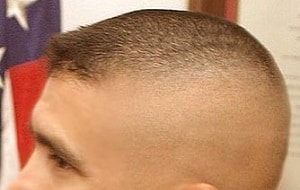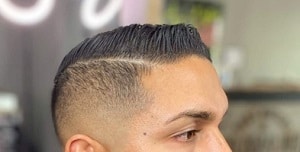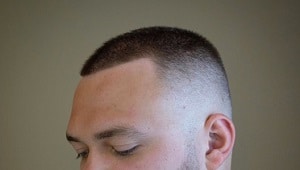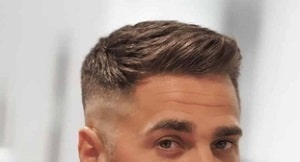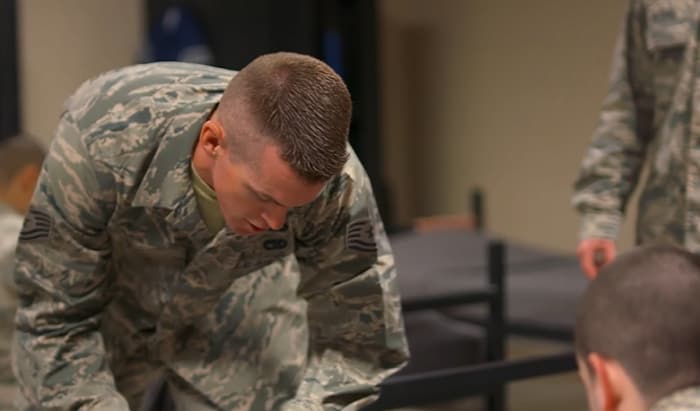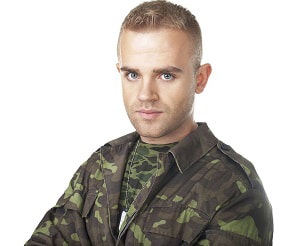If you have seen photos of military members in basic training, you will know that they all sport a shaved head or a very short buzz cut. But do you know why this is? Why do they shave your head in the military?
Originally, the military cut your hair to maintain and ensure cleanliness. But today, many other reasons can be named for military shaved heads and military buzz cut fades.
In this article, we will look at all the different reasons. So, to not miss out on any details, make sure you read until the conclusion at the very end!
Table of Contents
Haircut in the Military 101
Recruits get their buzz cuts shortly after arriving at basic military training. Then, throughout the rest of boot camp, recruits get trim cuts once a week. Depending on the branch, a buzz cut may not be repeated but the back and sides may be trimmed.
At the start, male recruits look like they have shaved heads because of the drastic different change via the close buzz cut. But by the time they graduate from basic training, recruits will have a bit more hair which will be more visible.
When recruits leave basic training, military members can either continue to wear their buzz cut or get a new approved regulation haircut. Options include:
- Crew cut
- Flat top
- High and tight
- Regulation cut
- High fade
- Low fade
- Butch cut
- Burr cut
- Ivy League cut
The Brief Military Haircut History
Since the civil war, male personnel had to get very close haircuts upon induction. Hence, these cuts were also known as induction cuts. At the time, the official reason was cleanliness. The buzz cut military helps reduce the risk of spreading lice (hair and body) for field sanitation.
Nowadays, the induction cut is still implemented, and there are many other reasons why. This next part will dive into the details.
1. Standardization
One reason for recruits getting the induction cut, regardless of whether they are in the Army, in the Air Force, or in the Marines, is standardization. In other words, everyone looks like uniformed soldiers. This promotes a professional appearance for troops in particular and the military in general.
Sense of Uniformity, Cohesion & Equality
The standardization leads directly to a sense of uniformity, cohesion, and equality. It instills all these in the recruits, which goes a long way for future teamwork and cooperation.
2. Easy Management & Care
If you have long hair, you know that it is a hassle to take care of. Short hair, like the crew cut Army makes sure management and care do not take too much time and effort.
For example, you can cut down on the time you take in the shower. You just need to wipe dry your head or hair with a fresh towel, and you do not need to use other hair products, such as styling creams.
3. Reduce Risks
Long hair can easily get caught, especially in windy conditions, in the equipment that military members frequent, like helmets, masks, and weapons. This can interfere with the members’ efficiency in whatever operation or mission they are on.
Plus, long hair does not always neatly frame the face. When encountering wind, it can fly all over the face and fall into the eyes. This can affect the members’ vision and ability to perform well during operations and missions. It can also be quite frustrating. So, shorter hair is ideal.
4. Spirit of Tradition
Hair Requirements for Female Recruits
We have looked at the induction cut for male recruits, but what about female recruits? Do women have to shave or cut their hair too?
Unlike their male counterparts, women do not have to do so in basic training. There are even policies in the U.S Army that women CANNOT shave off their hair.
Nonetheless, they have hair requirements that they have to follow, just like male recruits. Their hair must be well-kept, neat, and clean. So, they can appear professional.
Upon arriving at basic training, female recruits must ensure that their hair meets the following criteria:
- Your hair cannot go past the bottom of your uniform’s collar
- Your hair bangs cannot go below the eyebrows
Still, those members with short hair in the military female are preferred.
Most recruits with long hair will put theirs into a bun. Here is how they would go about it:
Method 1 – Using a sock
You will need the following:
- A pair of socks
Use your military-issued black dress socks, as they are thick and stretchy enough. If you want to buy the socks, be sure to select ones that are the same color as your hair. So, even if they show, they will not stand out.
- Scissors
- Comb or hairbrush
- Elastic hair ties
- Bobby pins
- Step 1: Put on one of the socks and roll it from the top down to your ankle.
- Step 2: Take the sock off while still keeping it rolled up.
- Step 3: Cut the toe part from the sock with the pair of scissors you have prepared.
- Step 4: Continue to roll the sock until it forms a donut shape.
- Step 5: Part your hair, if necessary.
- Step 6: Put your hair into a ponytail using an elastic hair tie. Make sure your ponytail is secured tightly and drops around your neck’s nape.
- Step 7: Secure your bangs (if you have them) with bobby pins.
- Step 8: Thread your ponytail through the sock donut you have made.
- Step 9: Slide the donut up to where the elastic hair tie securing your ponytail is.
- Step 10: Tilt your head down. Next, flip your hair and spread it over the sock.
- Step 11: Secure your hair tightly with another elastic hair tie
- Step 12: Twist the ends and tuck them under the bun.
- Step 13: Hide any remaining loose hair using bobby pins.
Method 2 – Without using a sock
- Step 1: Brush and detangle your hair using a comb or hairbrush.
- Step 2: Run your hair under water.
- Step 3: Dry your hair slightly using a towel so that it is not dripping wet, just damp.
- Step 4: Comb or brush through your hair to get rid of any persisting bumps.
- Step 5: Put your hair into a ponytail using an elastic tie.
- Step 6: Lift your ponytail up and twist it at the same time with your fingers.
- Step 7: Wrap the twisted part around your ponytail’s base slowly and carefully until everything.
- You can stop once everything is wrapped and there are no bumps and excess strands.
Keep the bun in place using bobby pins or put on a hairnet.
As of 2021, female military personnel will be allowed to have buzz cuts. Women will now also be able to have highlights in their hair as long as they are of conservative shades and do not look faddish, eccentric, or exaggerated.
Here is an example of a female military buzz cut:
Specific Standards for Service Branches
1. The U.S Army
- Your hair must not appear trendy. It must also not be disheveled or spiky-looking.
- Your hair must be tapered at the neckline to conform to the shape of the head.
- Your hair must not drop over the ears or reach the collar.
- You are allowed to wear har accessories to hide hair loss but these must abide by haircut policies.
- Your hair color must be in a natural shade.
Here is an example of an Army boot camp haircut:
2. The U.S Air Force
- Your hair must be tapered above the ears and at the neck’s nape.
- Your hair must not touch the ears, eyebrows, or collar.
- Your hair length and bulk must not disturb proper headgear.
- Your hair color must look natural.
3. The U.S Marine Corps
- Your hair must be evenly graduated from no length at the hairline.
- Your hair must not have outline or edging.
- Your hair must not go past 3 inches in length.
- Your hair must not be styled in a way that it extends from the scalp by more than 2 inches.
- Your hair must not show beneath proper headgear.
- Your hair color must look natural.
- Your hair must be tapered from the hairline upward at least ¾ inch.
- Your hair must be above the ears and at the nape of the neck.
- Your hair must not touch the ears, eyebrows, or collar.
- Your hair must not be longer than four inches.
- Your hair length and bulk must not disturb proper headgear.
- Your hair must not be styled so that it goes more than 2 inches from the scalp.
- Your hair color must look natural.
Exceptions
In special cases, special operation forces like the Navy SEALs and Green Berets are allowed to deter from the standard regulations during operations and missions to blend into civilian populations. This is also referred to as “social camouflage.” They may be permitted to grow their head and facial hair out and reduce their risk of looking atypical or suspicious.
Conclusion
Now, you know the answer to, “Why do they shave your head in the military?” Hopefully, you have learned a lot from this article. In case you still have questions, we have opened the comments. Leave any queries there and will be sure to get back to you. Otherwise, please share your thoughts in the comments. Please help us share this article with other readers as well!

I am Everett Bledsoe, taking on the responsibility of content producer for The Soldiers Project. My purpose in this project is to give honest reviews on the gear utilized and tested over time. Of course, you cannot go wrong when checking out our package of information and guide, too, as they come from reliable sources and years of experience.




